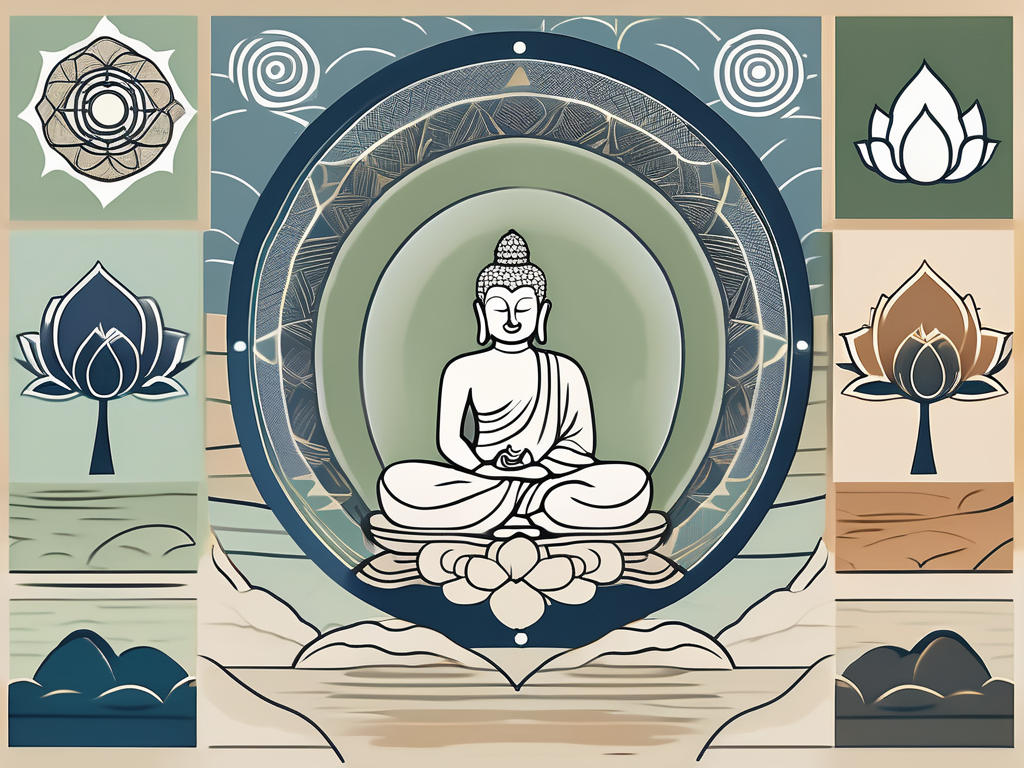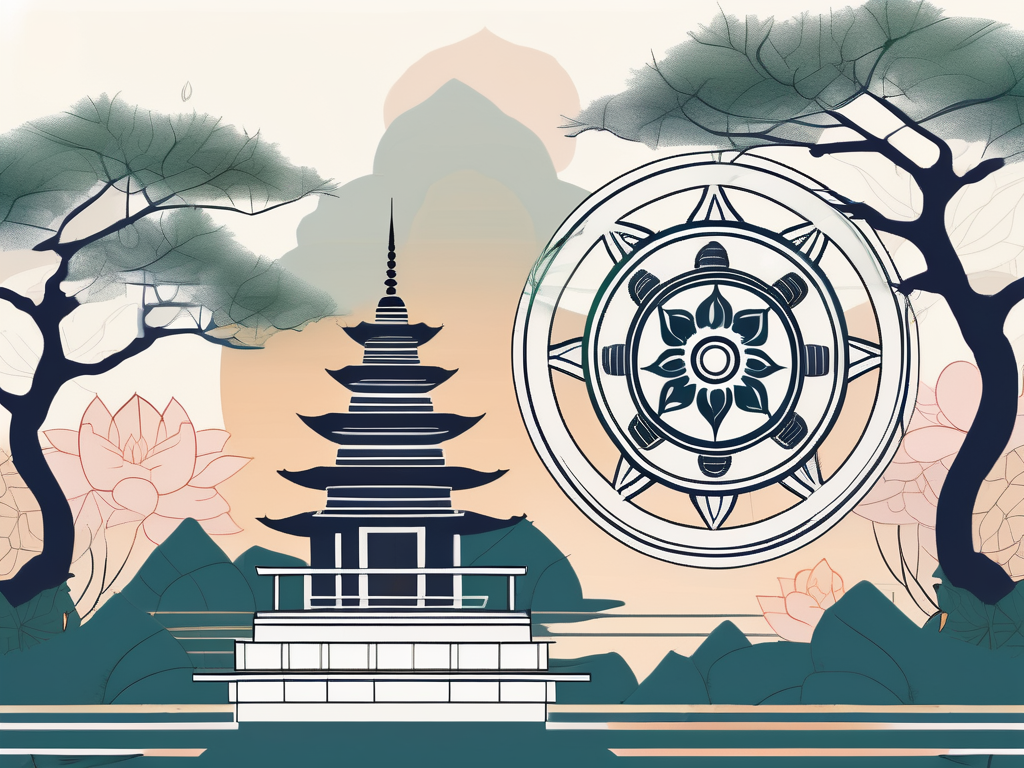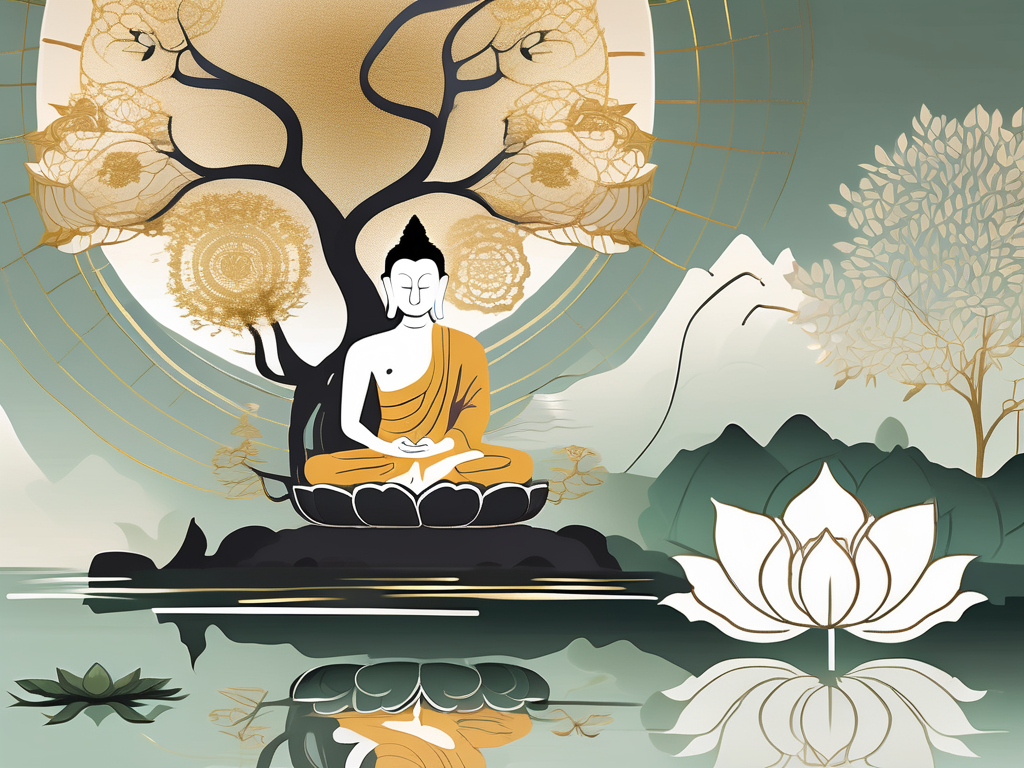Buddhism is a diverse and fascinating spiritual tradition that has captured the hearts and minds of millions of people around the world. Its rich history and profound teachings have sparked the curiosity of many seekers on the path to enlightenment. In this comprehensive guide, we will explore the various types of Buddhism, shedding light on their core beliefs, the birth and spread of the religion, and the key teachings and practices of each school. So, come along on this enlightening journey as we delve into the world of Buddhism!
Understanding Buddhism: An Overview
Before delving into the different types of Buddhism, it is essential to gain a basic understanding of the core beliefs that underpin this ancient tradition. Buddhism is based on the teachings of Siddhartha Gautama, also known as the Buddha, who lived around the 5th century BCE. The central idea of Buddhism is that life is characterized by suffering, and the ultimate goal is to attain liberation from this suffering through enlightenment.
Buddhism is a rich and complex philosophy that encompasses a wide range of beliefs and practices. It is not simply a religion but also a way of life, a philosophy, and a psychology. The teachings of Buddhism offer profound insights into the nature of reality, the human condition, and the path to liberation.
The Core Beliefs of Buddhism
At the heart of Buddhism are the Four Noble Truths and the Eightfold Path. The Four Noble Truths state that suffering exists, suffering arises from attachment and desire, suffering can be overcome, and there is a path to end suffering. These truths provide a framework for understanding the nature of suffering and offer a roadmap to liberation.
The First Noble Truth acknowledges the existence of suffering in the world. It recognizes that life is filled with pain, dissatisfaction, and impermanence. This truth encourages individuals to confront the reality of suffering and not shy away from it.
The Second Noble Truth explains that suffering arises from attachment and desire. It suggests that our attachment to material possessions, relationships, and even our own identities leads to suffering. By letting go of attachments and desires, one can find freedom from suffering.
The Third Noble Truth offers hope by stating that suffering can be overcome. It emphasizes that liberation from suffering is possible through the practice of mindfulness, compassion, and wisdom. This truth instills a sense of optimism and encourages individuals to embark on the path to enlightenment.
The Fourth Noble Truth introduces the Eightfold Path, which provides guidelines for living a righteous and fulfilled life. This path consists of practices such as Right View, Right Intention, Right Speech, Right Action, Right Livelihood, Right Effort, Right Mindfulness, and Right Concentration. Each aspect of the Eightfold Path is interconnected and supports the cultivation of wisdom, ethical conduct, and mental discipline.
Right View involves understanding the true nature of reality and seeing things as they really are. It requires developing insight into the impermanent and interconnected nature of all phenomena. Right Intention focuses on cultivating wholesome intentions and letting go of harmful desires. It encourages individuals to act with kindness, compassion, and generosity.
Right Speech emphasizes the importance of using words that are truthful, kind, and helpful. It encourages individuals to refrain from gossip, slander, and harsh speech. Right Action involves engaging in actions that are ethical and non-harming. It promotes respect for all living beings and encourages individuals to refrain from killing, stealing, and engaging in sexual misconduct.
Right Livelihood encourages individuals to earn a living in a way that is ethical and aligned with their values. It discourages engaging in occupations that cause harm to others or involve unethical practices. Right Effort emphasizes the cultivation of wholesome qualities and the abandonment of unwholesome ones. It encourages individuals to develop positive mental states and overcome negative habits.
Right Mindfulness involves cultivating a moment-to-moment awareness of one’s thoughts, feelings, and bodily sensations. It encourages individuals to be fully present and attentive to the present moment. Right Concentration focuses on developing deep states of concentration and mental stability through meditation. It allows individuals to cultivate a focused and tranquil mind, leading to insight and liberation.
By following the Eightfold Path, individuals can gradually transform their minds and attain liberation from suffering. It is a lifelong journey that requires dedication, discipline, and self-reflection. Buddhism offers a comprehensive framework for personal and spiritual development, providing guidance for individuals seeking a path to enlightenment.
The Birth and Spread of Buddhism
The life of Siddhartha Gautama, the founder of Buddhism, is shrouded in legend and lore. Born into a royal family in ancient India, Siddhartha renounced his privileged life and embarked on a spiritual quest for truth and enlightenment. After years of meditation and self-reflection, he attained enlightenment under a bodhi tree, becoming the Buddha.
The Life of Siddhartha Gautama
Siddhartha Gautama’s life was marked by a deep sense of compassion and a burning desire to alleviate the suffering of others. He traveled far and wide, teaching his profound insights and gathering disciples along the way. His teachings, known as the Dharma, spread like wildfire across Asia, taking root in various countries and giving rise to different schools of Buddhism.
One of the most significant aspects of Siddhartha Gautama’s life was his renunciation of his royal privileges. He willingly gave up a life of luxury and opulence to seek a greater truth. This act of renunciation not only demonstrated his commitment to spiritual growth but also served as an inspiration for his followers. Siddhartha’s decision to abandon his comfortable life and embrace a path of simplicity and self-discipline resonated deeply with those who sought a more meaningful existence.
Throughout his travels, Siddhartha encountered people from all walks of life. He engaged in conversations with kings and beggars, scholars and farmers, and listened attentively to their stories and struggles. This exposure to the diverse range of human experiences deepened his understanding of suffering and compassion, shaping the core principles of Buddhism.
Under the bodhi tree, Siddhartha experienced a profound awakening. He gained insight into the nature of existence, the causes of suffering, and the path to liberation. This enlightenment marked the beginning of his role as the Buddha, the awakened one. From that moment on, he dedicated his life to sharing his newfound wisdom with others, guiding them towards liberation from the cycle of birth, death, and rebirth.
Buddhism’s Journey Across Asia
As Buddhism spread across Asia, it underwent various transformations, adapting to the local customs, traditions, and cultural contexts of each region. The teachings of the Buddha resonated with people from different backgrounds, offering a path to inner peace and liberation from suffering.
In India, the birthplace of Buddhism, the teachings of the Buddha found fertile ground. Monastic communities were established, and the Dharma flourished. The teachings of the Buddha were recorded in scriptures, preserving his wisdom for future generations. Over time, however, Buddhism faced challenges from other religious and philosophical traditions, leading to its decline in its country of origin.
In Sri Lanka, Buddhism took root and became deeply ingrained in the culture and society. The ancient city of Anuradhapura became a center of Buddhist learning and practice, attracting scholars and monks from far and wide. The teachings of the Buddha spread throughout the island, influencing every aspect of Sri Lankan life, from art and architecture to governance and social norms.
Thailand, known as the Land of Smiles, embraced Buddhism as its dominant religion. Monasteries, known as wats, dot the landscape, serving as centers of spiritual practice and community gathering. Thai Buddhism incorporates elements of animism and Hinduism, creating a unique blend of religious traditions.
In Cambodia, the majestic temples of Angkor Wat stand as a testament to the influence of Buddhism. The Khmer Empire, which ruled over Cambodia from the 9th to the 15th century, embraced Buddhism as its state religion. The temples of Angkor Wat, with their intricate carvings and grandeur, reflect the devotion and spiritual aspirations of the Khmer people.
Japan, with its rich cultural heritage, developed its own unique form of Buddhism known as Zen. Zen Buddhism emphasizes direct experience and meditation, seeking to awaken individuals to their true nature. Zen gardens, tea ceremonies, and martial arts are all expressions of the Zen spirit that permeates Japanese culture.
China, a land of ancient wisdom and profound spirituality, welcomed Buddhism with open arms. The teachings of the Buddha blended harmoniously with existing Chinese philosophies, such as Confucianism and Taoism. Buddhist temples and monasteries became centers of learning and meditation, attracting scholars and seekers from all corners of the empire.
In Korea, Buddhism played a pivotal role in shaping the nation’s history and culture. Monks and scholars traveled to China to study Buddhist scriptures and bring back the teachings to their homeland. The influence of Buddhism can be seen in Korean art, literature, and architecture, with temples nestled amidst serene mountainscapes.
Tibet, often referred to as the “Roof of the World,” became a stronghold of Buddhism. The Tibetan people embraced Buddhism as their spiritual path, with monastic institutions playing a central role in society. Tibetan Buddhism, with its intricate rituals and esoteric practices, captivated the imagination of spiritual seekers worldwide.
Mongolia, known for its vast steppes and nomadic traditions, adopted Buddhism as its state religion in the 16th century. The teachings of the Buddha resonated with the Mongolian people, offering solace and guidance in their nomadic lifestyle. Monasteries, known as khuruls, became centers of spiritual and cultural life.
Vietnam, a country with a rich history and vibrant culture, embraced Buddhism as one of its major religions. The teachings of the Buddha found a home in Vietnam, influencing its art, architecture, and social customs. Buddhist temples, adorned with intricate carvings and vibrant colors, stand as symbols of spiritual devotion.
As Buddhism spread across Asia, it continued to evolve and adapt to the changing times. Different schools of Buddhism emerged, each with its own unique emphasis and practices. From the Theravada tradition in Southeast Asia to the Mahayana tradition in East Asia, Buddhism took on diverse forms, catering to the needs and aspirations of its followers.
Today, Buddhism continues to inspire millions of people around the world. Its teachings of compassion, mindfulness, and wisdom offer a path to inner peace and liberation. From the ancient scriptures to the modern-day practitioners, the journey of Buddhism is a testament to the enduring power of spiritual wisdom.
Theravada Buddhism: The School of the Elders
Theravada Buddhism, also known as the School of the Elders, is the oldest surviving branch of Buddhism. It is primarily practiced in Sri Lanka, Thailand, Cambodia, Laos, and Myanmar. Theravada Buddhists adhere closely to the original teachings of the Buddha, as preserved in the Pali Canon.
Key Teachings and Practices
At the heart of Theravada Buddhism is the pursuit of personal enlightenment, a journey that requires deep meditation and meticulous observance of the moral precepts. The ultimate goal is to attain Nirvana, a state of liberation from the cycle of birth, death, and rebirth.
Major Theravada Buddhist Countries
Sri Lanka stands as the cradle of Theravada Buddhism, and it is home to many sacred sites and monasteries. Thailand, with its abundance of ornate temples and the practice of meditation retreats, has also become a hotbed of Theravada Buddhism.
Mahayana Buddhism: The Great Vehicle
Mahayana Buddhism, often referred to as the Great Vehicle, developed as a more inclusive and accessible form of Buddhism. It emphasizes the ideal of the bodhisattva, a compassionate being who seeks to attain enlightenment for the benefit of all sentient beings.
The Bodhisattva Ideal in Mahayana
In Mahayana Buddhism, individuals strive not only for personal liberation but also for the liberation of all beings. The bodhisattva ideal is epitomized by figures like Avalokiteshvara, the bodhisattva of compassion, who embodies selfless love and compassion towards all living beings.
Different Sects within Mahayana Buddhism
Mahayana Buddhism gave rise to various sects and traditions, each with its own distinctive practices and philosophical outlooks. The Zen tradition, with its emphasis on meditation and direct experience, and the Pure Land tradition, which focuses on the chanting of sacred mantras, are just two examples of the diversity within Mahayana Buddhism.
Vajrayana Buddhism: The Diamond Vehicle
Vajrayana Buddhism, also known as the Diamond Vehicle, is primarily practiced in Tibet, Mongolia, Bhutan, and parts of Nepal. It is characterized by its esoteric rituals, elaborate visual symbolism, and the use of tantra as a means to attain enlightenment swiftly.
The Role of Rituals and Tantra
Rituals play a significant role in Vajrayana Buddhism, serving as a means to invoke the divine and connect with higher states of consciousness. The use of mantras, sacred chants, and the visualization of deities are integral to Vajrayana practice. Tantra, a powerful form of meditation, is employed to transform ordinary experiences into paths to awakening.
Vajrayana Buddhism in Tibet and Mongolia
Tibet and Mongolia have been the strongholds of Vajrayana Buddhism for centuries. These regions are known for their monastic traditions, the reverence for spiritual teachers, and the breathtaking monasteries that dot the Himalayan landscape. Vajrayana Buddhism is deeply ingrained within the cultural fabric of these countries.
In conclusion, Buddhism encompasses a wide array of beliefs, practices, and schools, each offering a unique path to enlightenment. Whether you find solace in the simplicity of Theravada Buddhism, the compassion of Mahayana Buddhism, or the mysticism of Vajrayana Buddhism, there is a tradition that resonates with every seeker. So, explore, learn, and embrace the profound teachings of Buddhism as you embark on your own journey towards inner peace and awakening!












